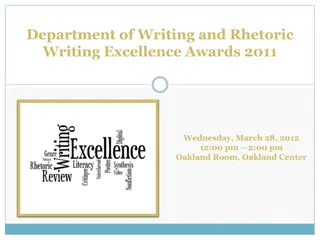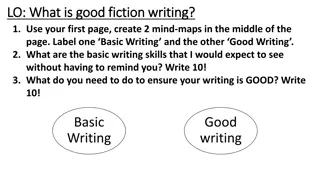Exploring Historical Fiction Writing Techniques
Delve into the art of historical fiction writing through thematic exploration, character development, and crafting compelling narratives set in specific historical periods. Enhance your skills in characterisation, setting, atmosphere, turning points, and climax by engaging in creative tasks such as crafting six-word stories and analysing character traits in sample paragraphs.
Download Presentation

Please find below an Image/Link to download the presentation.
The content on the website is provided AS IS for your information and personal use only. It may not be sold, licensed, or shared on other websites without obtaining consent from the author. Download presentation by click this link. If you encounter any issues during the download, it is possible that the publisher has removed the file from their server.
E N D
Presentation Transcript
IMAGINATIVE WRITING Historical Fiction
To revise characterisation, setting, atmosphere, turning points, and climax in imaginative writing LEARNING INTENTIONS To explore writing thematically To create our own imaginative pieces which centre around a specific historical period
STARTER TASK SIX WORD STORIES You don t need to write 1,000 words to tell a story. Some stories can be told in as little as six words. In this task, you will be asked to write a story using only six words. Let s look at some examples before we begin.
STARTER TASK SIX WORD STORIES Try writing your own six word stories. They can be about any subject at all, as long as they contain only six words. The six words you use should provide as much information as possible.
REVISION - CHARACTERISATION What is characterisation? How can we make characters come to life in our writing?
Read the following paragraph and then write down what this paragraph tells us about the character of Jamie s mother. Make five points. Jamie winced as his mother grabbed him, pulling him into the house as she carried on nagging him. In the space of the next ten minutes Jamie had his entire face, neck, cheeks and ears scrubbed. His shirt was pulled from him and a clean one replaced it. A fresh handkerchief was stuffed in his pocket; his teeth were re-brushed, clean socks thrust on his feet, and his trainers sprayed with scuffguard. CHARACTERISATION: TASK
REVISION - CHARACTERISATION We can develop the characters in our stories through describing: Appearance Personality Physical movements Behaviour Speech Attitudes How they treat others
REVISION SETTING AND ATMOSPHERE What is setting? What is atmosphere? How do we create effective setting and atmosphere in our stories?
REVISION SETTING AND ATMOSPHERE To create setting we can describe: What the place looks, smells, sounds and feels like Time and place Temperature and weather To create atmosphere we can: Choose words or phrases to create a mood Use similes and metaphors Use sound techniques like alliteration and personification
Write a descriptive and atmospheric paragraph about one of the following settings: A graveyard SETTING AND ATMOSPHERE: TASK A theme park A football match A concert
REVISION TURNING POINTS AND CLIMAX What is a turning point? Why do we need turning points in our story? What is a climax? How can we make the climax of a story effective?
TASK LITTLE RED RIDING HOOD LRRH decides to visit her Grandma She stops on her way through the forest to pick flowers A wolf appears and speaks to her She rushes off to her Grandma s house The wolf takes a shortcut and goes to Grandma s house He eats her and then dresses up as her LRRH gets to the house and almost gets eaten by him A woodsman hears her and rescues her and her Grandma He then takes the wolf far away The end.
TASK LITTLE RED RIDING HOOD Read the story Little Red Riding Hood and consider what the turning points are. You can note these down in a bullet-point list. You should then consider what the climax of the story is.
TASK LITTLE RED RIDING HOOD LRRH decides to visit her Grandma She stops on her way through the forest to pick flowers A wolf appears and speaks to her She rushes off to her Grandma s house The wolf takes a shortcut and goes to Grandma s house He eats her and then dresses up as her LRRH gets to the house and almost gets eaten by him A woodsman hears her and rescues her and her Grandma He then takes the wolf far away The end
What is a theme? Theme is the central, underlying, and controlling idea or insight of a work of literature. It could represent the writer or character s view of the world, or could be a revelation or exploration of a human experience. THEME
Themes give stories layers and depth. Without them, stories are meaningless. THEME As a writer, it is your job to explore themes within your work.
WRITING THEMATICALLY Theme is a powerful tool. It's the statement that you, as the author, make about the topics your story discusses. A story s theme is often derived from the emotional development of its characters or from the consequences those characters face as a result of their external actions. By making good use of theme in your story, you create an emotional connection that attracts readers to your characters.
WRITING THEMATICALLY Readers should be able to draw out the theme for themselves by reading between the lines, by learning lessons and experiencing consequences alongside your main character(s) throughout the story. By starting the planning of your story with a central theme, you will be able to add an element of depth and maturity to your writing.
THEME: TASK Choose a film/book you have seen/read. Answer the following questions: 1. What is the plot of the film/book? 2. What themes and ideas does the film/book explore? 3. How does the film/book explore these themes and ideas?
Love Death Morality Power and Corruption Survival Courage Prejudice EXAMPLES OF THEMES Individual vs Society War Isolation Growing Up Ambition Betrayal Discovery Escape Fear
YOUR STORY - HISTORICAL FICTION Before you begin writing your story, you must first choose a historical period to set it in. This could be any time period you find interesting, such as: WWII Suffragettes Salem Witch Trials Native Americans 1980s Great Depression Make a list in your jotter of historical periods you find interesting.
RESEARCH TIME You are now going to do some research on your chosen time period I want you to create a setting board. You can collect information (about culture, key events, clothing, attitudes, etc.), photographs, eyewitness testimonies and anything else you find relevant. This will help you to create a world that is convincing and comprehensive which your story will then take place in. Try to fill two sides of A4 paper with your research.
PLANNING AND WRITING Now that you have your setting board, you should plan out the plot of your story, including the turning points and climax. You could do this as a bullet pointed list, a mind map, or a timeline. Remember, the plot of your story should contain some exploration of a theme or idea. Once you have completed your plan, show it to me and then you can begin writing. Your story should be between 600 and 1000 words.
To write a story set within a specific historical period. SUCCESS CRITERIA To explore a theme or idea within your story. To write a story which contains effective setting description, characterisation, atmosphere, turning points and climax.























